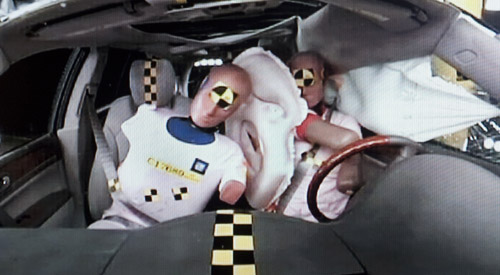We teach in our defensive driving class that in any crash, there are three collisions to worry about. The first collision is when your vehicle hits something – another vehicle, a tree, an embankment, etc. The second collision is when an occupant’s body is thrown against the vehicle structure. The third collision is when a person’s internal organs are slammed against each other or against the skeletal parts of the body. Horrifying, isn’t it? But fortunately, you have some “friends” in such a situation.
The Next thing we teach in defensive driving class is that modern vehicle is designed to collapse around you, and in so doing, it dissipates some of its stored energy. I’ve heard people say that cars aren’t made like they used to be. Thank heavens they aren’t. Since your vehicle IS made to crumple and absorb crash forces, it is more expensive to repair after the crash; but that high repair bill is a direct result of the significant crumple protection it affords you. In those old tank-like cars, line a 1959 Bel-Air, the rigid impact-resistant structure transmitted ALL of the crash forces directly to the passengers — guaranteeing that injuries would be the result of almost any crash.
Second, the modern vehicle’s interior appointments are designed to cause less injury to you in the “second collision.” Softer plastics, types of vinyl, & paddings are all meant to prevent injuries if you should be thrown into them. This is where the airbag comes into play. Manufacturers are making them “smarter” now — they can sense the severity of a crash and match that against the physical characteristics of the person in order to better calculate the opening forces and the timing required to best protect the occupant. Manufacturers continue to add side and curtain airbags to the available systems, further defining the “safe” space for you and your passengers.
Another thing we teach in our defensive driving class is about that “third” collision? Have you heard the term “impact ride-down.” This is similar to the function of a parachute. If you jump out of an airplane, it isn’t the fall that kills you. What kills is the sudden stop at the end! A parachutist avoids that sudden stop with his or her parachute. When a parachute opens, it does not slow the parachutist’s fall instantly, but it creates drag and slows the user’s descent gradually, over a few seconds, finally resulting in a survivable rate of descent (and impact). Your seat belt works the same way. In a crash, it stretches and tightens as you are thrown forward, resulting in a relatively gradual deceleration of your body and preventing some (if not all) of the injuries caused by the second and third collision impacts — this is “impact ride-down.” Hopefully, an SRS system is also present to further protect you from those second and third collision forces.
This brings me to this week’s rule: an airbag is a “supplemental” restraint because it does not work by itself. It works IN CONJUNCTION with your seat belts. It cannot help you if you’ve been thrown out of position. Correctly used, the seat belts keep you restrained in the exact place where the airbag can protect you. So make sure you use the two systems together, as their designers intended. If you do get an Arizona traffic ticket take our defensive driving class. 2passdd.com

